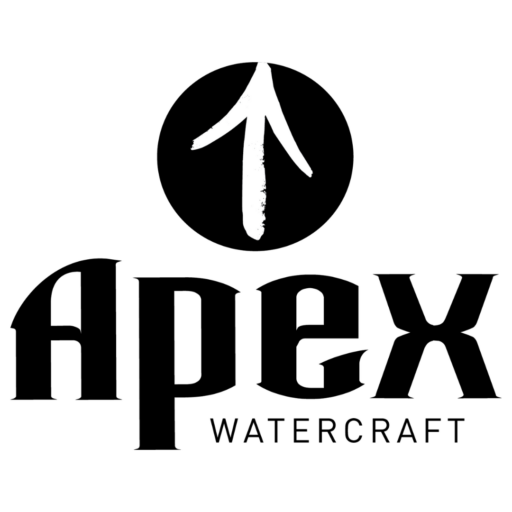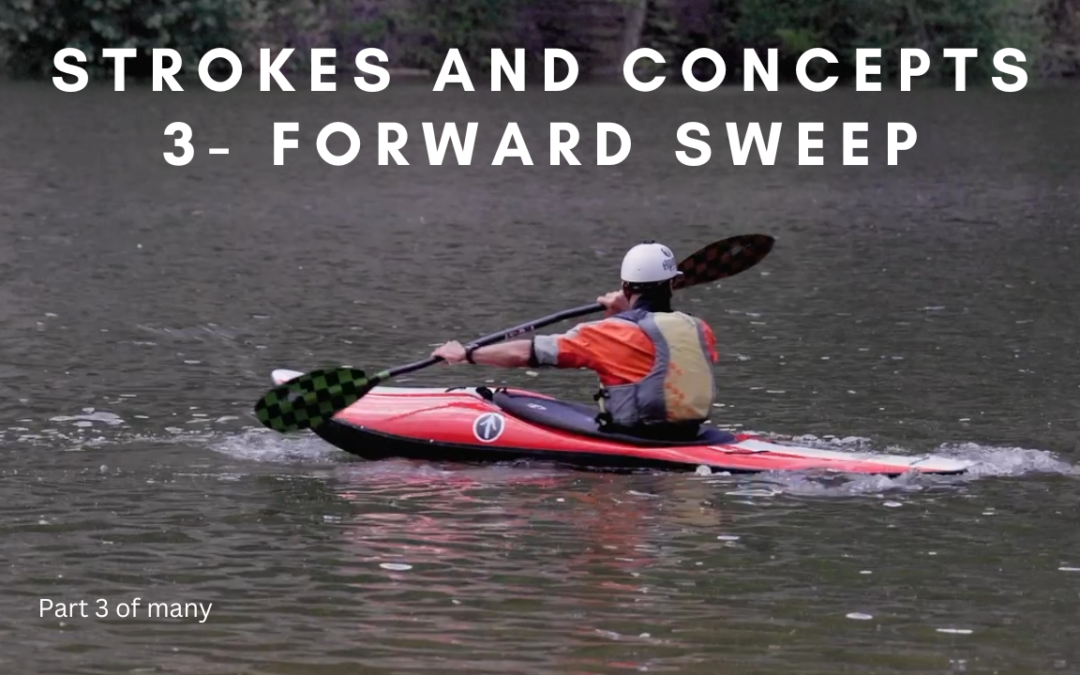The Primary Turn Strokes
Forward and Reverse Sweeps
These are the strokes you use to get the boat spinning in the direction you want it too. They are your strongest turning strokes.
Because we are now discussing turning the kayak, we need to learn a few new rules that make a big difference in your boating.
First Two Rules of Turning:
Head: Your head always looks at your target. While we already discussed this, we haven’t really gotten into it, and you are not really doing it right yet, most likely. In order to have your head look at your target, you need to know what your target is, and spot that target no matter where your boat is pointed. Most people can look at their target only IF the boat is pointed at the target. On a peel out, ferry, or most moves that require turning, the bow of the boat is not pointed where you are going. However, your head should be.
Body: You body should lead every turn. What this means is that if you want to turn your boat to the left, you first turn your body to the left, pointing your chest over the left side of the boat. Your body should remain pointed over the left side of the boat until you are done turning, or you want to turn the other way. What is cool about this rule is just how universal it is. Remember how we discussed the forward stroke being a turning stroke, as it must make the kayak turn left and right on each stroke in order for the kayak to go straight overall? Using torso in your forward stroke is also following the rule of your body LEADING the turn. When you are “wound-up” on for a right stroke, your body is pointing over the left side of the boat, preparing for your right stroke, which will make the boat turn left. The most common mistake people make when turning is letting their body get behind the turn, which has devastating effects on the turn, overall control of the boat, your speed, ability to see, and for a playboater, your ability to do moves.
Forward Sweep
Drill:
10 forward sweeps on the left
10 forward sweeps on the right
The forward sweep is the stroke you use when you want to move the boat forward and get it turning at the same time. A forward sweep can be done in its pure form, which is the most effective for turning, or it can migrate towards the forward stroke, when you don’t need as much turning force.
Head: Head points at your target- for this drill, we will be going in circles, so you will be like a dog chasing your tail, and you will never get to your target. Your target will be the stern of your kayak.
Body: Your body will start off as rotated in the direction you plan on turning, and then remain there until you are doing doing sweeps. If you are turning left, rotate your body left and keep it fully wound up through out the sweep. You have most likely been taught to “unwind” or use torso in your sweep, we are not going to do that.
Boat: We will keep the boat flat for this drill, try not to use any edge during the sweep.
Paddle: Paddle goes in at the toes and out at the hip like the forward stroke, BUT, the top hand is as far back and low as possible. The goal is to get the paddle positioned to push the bow straight away from the blade. Remember that every paddle stroke should push you in the direction you want to go. We want the bow to push straight to the side to rotate the boat as quickly as possible.
The reason for not unwinding or using torso in your forward sweep if you want to continue turning is that when you do the sweep stroke, if you keep your body wound up, your sweep will rotate your body weight as well as your kayak and the mass of your body will help carry the boat around the turn after you finish the sweep. If you unwind or use torso in the sweep your body is actually stationary along with the paddle in the water and only the boat/legs get moving from the sweep. Because of the way water resistance works (it increases by 8 times when you move the boat twice as fast) using torso which rotates the boat faster at first causes most of the energy you used in the sweep to bleed away in the form of water resistance. Add to that the fact that your body weight isn’t moving and the boat’s momentum now has to get your body moving at the end of the sweep and you don’t get as far on a single sweep. The drill I do, shows how you can do a proper sweep, keeping your body leading the turn and with only two sweeps you can make a full 360 with lots of extra speed at the end. It takes three sweeps to do the same thing using a much longer, full torso sweep that was traditionally taught in kayak schools and certification classes (meaning that you have to learn how to do the sweep incorrectly to be able to teach kayaking in most countries).
Drills:
Level 1: During the sweep- keep your eyes focused on your stern, keep your boat flat.
Level 2: Pick a piece of water that you are sweeping to as your target and keep finding and doing the quick focus on your piece of water. This gives you practice picking and focusing on targets quickly.
Level 3: Using a playboat, practice dropping your outside edge and sweeping your stern under the water and your bow up in the air. It is a combination of edge control, and lifting your knees to engage the stern at the right moment.

